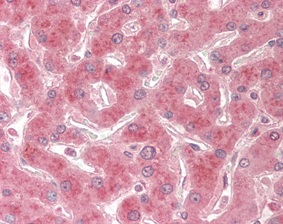Functional TRAIL-R2 (human) Antibody, mAb(preservative free)
- SPECIFICATION
- CITATIONS
- PROTOCOLS
- BACKGROUND

Application
| IHC-P, FC, ICC, IP |
|---|---|
| Primary Accession | O14763 |
| Reactivity | Human |
| Host | Purified From Concentrated Hybridoma Tissue Culture Supernatant. |
| Clonality | Monoclonal |
| Isotype | Mouse IgG1 |
| Gene Source | Human |
| Application Note | FC,Functional Application, Inhibition (blocks TRAIL-R2 mediated killing if applied in solution),ICC,IHC-P(15 µg/ml),IP, |
| Clone Names | HS201 |
| Calculated MW | 47878 Da |
| Dilution | IHC-P~~N/A FC~~1:10~50 ICC~~N/A IP~~N/A |
| Gene ID | 8795 |
|---|---|
| Other Names | TRAIL Receptor 2; DR5; KILLER; TNFRSF10B; CD262 |
| Target/Specificity | Recognizes human TRAIL-R2. Does not cross-react with human TRAIL-R1, -R3 or -R4. |
| Format | Liquid. In PBS containing 10% glycerol and 0.02% sodium azide. |
| Reconstitution & Storage | Stable for at least 1 year after receipt when stored at -20°C. |
| Precautions | Functional TRAIL-R2 (human) Antibody, mAb(preservative free) is for research use only and not for use in diagnostic or therapeutic procedures. |
| Name | TNFRSF10B |
|---|---|
| Synonyms | DR5, KILLER, TRAILR2, TRICK2, ZTNFR9 |
| Function | Receptor for the cytotoxic ligand TNFSF10/TRAIL (PubMed:10549288). The adapter molecule FADD recruits caspase-8 to the activated receptor. The resulting death-inducing signaling complex (DISC) performs caspase-8 proteolytic activation which initiates the subsequent cascade of caspases (aspartate-specific cysteine proteases) mediating apoptosis. Promotes the activation of NF-kappa-B. Essential for ER stress-induced apoptosis. |
| Cellular Location | Membrane; Single-pass type I membrane protein. |
| Tissue Location | Widely expressed in adult and fetal tissues; very highly expressed in tumor cell lines such as HeLaS3, K-562, HL-60, SW480, A-549 and G-361; highly expressed in heart, peripheral blood lymphocytes, liver, pancreas, spleen, thymus, prostate, ovary, uterus, placenta, testis, esophagus, stomach and throughout the intestinal tract; not detectable in brain |

Thousands of laboratories across the world have published research that depended on the performance of antibodies from Abcepta to advance their research. Check out links to articles that cite our products in major peer-reviewed journals, organized by research category.
info@abcepta.com, and receive a free "I Love Antibodies" mug.
Provided below are standard protocols that you may find useful for product applications.
Background
TRAIL-R2 is a receptor for the cytotoxic ligand TRAIL. The adapter molecule FADD recruits caspase-8 to the activated receptor. The resulting death-inducing signaling complex (DISC) performs caspase-8 proteolytic activation which initiates the subsequent cascade of caspases (aspartate-specific cysteine proteases) mediating apoptosis. Promotes the activation of NF-kappa.
If you have used an Abcepta product and would like to share how it has performed, please click on the "Submit Review" button and provide the requested information. Our staff will examine and post your review and contact you if needed.
If you have any additional inquiries please email technical services at tech@abcepta.com.













 Foundational characteristics of cancer include proliferation, angiogenesis, migration, evasion of apoptosis, and cellular immortality. Find key markers for these cellular processes and antibodies to detect them.
Foundational characteristics of cancer include proliferation, angiogenesis, migration, evasion of apoptosis, and cellular immortality. Find key markers for these cellular processes and antibodies to detect them. The SUMOplot™ Analysis Program predicts and scores sumoylation sites in your protein. SUMOylation is a post-translational modification involved in various cellular processes, such as nuclear-cytosolic transport, transcriptional regulation, apoptosis, protein stability, response to stress, and progression through the cell cycle.
The SUMOplot™ Analysis Program predicts and scores sumoylation sites in your protein. SUMOylation is a post-translational modification involved in various cellular processes, such as nuclear-cytosolic transport, transcriptional regulation, apoptosis, protein stability, response to stress, and progression through the cell cycle. The Autophagy Receptor Motif Plotter predicts and scores autophagy receptor binding sites in your protein. Identifying proteins connected to this pathway is critical to understanding the role of autophagy in physiological as well as pathological processes such as development, differentiation, neurodegenerative diseases, stress, infection, and cancer.
The Autophagy Receptor Motif Plotter predicts and scores autophagy receptor binding sites in your protein. Identifying proteins connected to this pathway is critical to understanding the role of autophagy in physiological as well as pathological processes such as development, differentiation, neurodegenerative diseases, stress, infection, and cancer.


